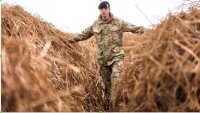Two sets of opposing trench systems, with a no man’s land between them, were found beneath heathland at the Ministry of Defence’s Browndown site in Gosport.
Gosport Council’s conservation officer Rob Harper spotted the trenches on a 1950s aerial photograph recently.
Armed forces volunteers are now helping to map and record the battlefield site.
The size of 17 football pitches, each trench system had a 200m long (660ft) front line, supply trenches and dug outs.
Describing his discovery, Mr Harper, said: "I was looking for something else. I was looking for Second World War pillboxes and features associated with an airfield nearby and I came across this 1951 plan in the office of this area in Gosport.
"I couldn’t believe it because in one corner of this plan was your absolutely classic First World War trench system."
Mr Harper then set out to investigate what the site looked like today.
"I found myself walking along a ditch and realised it was part of an elaborate trench system, hidden for all these years by bracken and gorse.
"I looked around and there were trenches everywhere.
"It’s quite jaw-dropping really. We are talking about an area of 500m (1,640ft) by 500m.
"It’s Ministry of Defence land but open to the public. Local people picnic here and are aware of the lumps and bumps but their origin has been a mystery until now.
Continue reading the main story
World War One at Home
Harold Bing
BBC Local Radio stories from a global conflict
Hear how Winchester Whisperer got round
How Ordnance Survey Mapped The War
"Gosport was a departure point for thousands of soldiers setting off to the trenches of Europe many of whom may well have practised here.
"But we haven’t yet found any records of who they were, what they did or what happened to them afterwards."
BBC presenter and historian Dan Snow, who is the president of the Council for British Archaeology, said it was "an entire replica" WW1 battlefield.
He said: "What strikes me about this, to be honest, is the scale of it.
"I never thought I would see something this large in the UK.
"It shows how serious they took the business of training and how serious it was here.
’Blank chapter’
"They had to send the guys out to France ready to do the hardest of tasks, something no-one had done before, that is to defeat the German army when they were dug in."
The site was described by MoD archaeologist Richard Osgood as a "truly remarkable site".
Historians are now trying to find documentary evidence providing more detail of what took place there.
David Hopkins, Hampshire county archaeologist, said: "It is well-known that troops were stationed at nearby Browndown Camp, but to date no historical records have emerged noting the practice trenches."
English Heritage and the Council for British Archaeology unveiled the discovery to mark the start of their national Home Front Legacy 1914-18 campaign.
It involves experts and volunteers working to find, identify and record a range of physical remains of the home front that are currently unknown or neglected.
Wayne Cocroft, English Heritage’s WW1 expert, said old documents and aerial photographs, "many of which haven’t seen the light of day since put away after the war," were being examined.
"We’re identifying former drill halls, requisitioned factories and farm buildings, pill boxes, secret listening stations, acoustic mirrors, prisoner-of-war camps and gun emplacements - places that deserve to have the part they played in history made known.
"Buildings from Tudor, Georgian, Victorian times…these are all well documented. But the built history of the First World War in England is virtually a blank chapter."
 Site officiel de"Vallée de la Cisse" : étudier de manière pluridisciplinaire les questions culturelles et diffuser les résultats des recherches par divers moyens sur nos 18 communes fédérées de la Vallée
Site officiel de"Vallée de la Cisse" : étudier de manière pluridisciplinaire les questions culturelles et diffuser les résultats des recherches par divers moyens sur nos 18 communes fédérées de la Vallée
